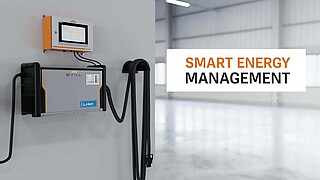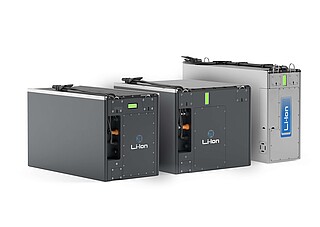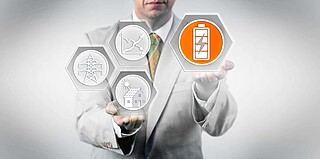More efficient and flexible charging
With "smart charging", it is possible to control very precisely when and how quickly the electrically powered fleet is charged. This has several advantages. It can, for instance, save a lot of money - if you know how.
Imagine a Tuesday morning on a cold winter's day in a large German city. It is still dark and there is no wind - neither photovoltaic systems nor wind turbines are supplying any electricity worth mentioning. In many households, people switch on the coffee machine, turn up the heating and blow-dry their hair after showering. In offices, the lights and computer screens come to life, in factories the machines start up. If you were to look at the electricity meter now, you would notice that it is spinning particularly fast. Electricity prices, however, are calculated according to supply and demand, and when particularly many people use electricity, the price increases. Sometimes drastically. On 8 December 2021, for example, the wholesale electricity price in Germany was at record 251.62 euros per MWh - the average electricity price in 2021 was only 96.85 euros per MWh. In addition, there are regional price differences and a very special German feature: large industrial customers who consume more than 100,000 kilowatt hours per year always pay the price of their highest monthly peak load. In other words, the higher the peak, the more expensive will be each individual kilowatt hour of electricity in that month.

Save money with lithium-ion technology
So electricity can be an expensive business. "In extreme cases, this is particularly annoying for customers who have switched to lithium-ion batteries specifically to save money," says Gesa Kaatz, Energy Advisor, STILL. After all, this is what lithium-ion drive promises: the batteries are up to 30 per cent more efficient than lead-acid batteries, the vehicles are more flexible and more readily available because no batteries need to be replaced - these and similar advantages compensate for the somewhat higher initial investment. However, if you charge your fleet at an inopportune time or send too many vehicles to the charging station at the same time, you will quickly pay extra. Especially with the high energy prices at present, this is a real problem. Yet there is a solution - the so-called Smart Energy Unit. A technology that monitors and controls when and how fast electric vehicles are charged. For it is true: a lot of money and energy can be saved with lithium-ion powered vehicles. You just need to know how.

One way to do this is to plan the utilisation of the vehicle fleet in such a way that it charges electricity at the most cost-effective times. The first prerequisite for this is to have the most comprehensive data possible - because this is the only way to derive relevant and usable information. There are digital tools for this, including those from STILL, where customers can monitor their own live data and evaluate it independently. "The control unit can be managed in a very user-friendly way via an integrated touch display or via a dashboard on the laptop," explains Maeggi Klein, Product Manager Energy Systems, STILL. Thus, the customer can see at a glance: When are the various trucks being used? Are there any breaks? "There are currently quite a lot of enquiries from customers about this. Our sales teams and energy experts give customers introductions and demonstrate the possibilities of the different settings," explains Kaatz.
Interim charging during breaks
Lithium-ion batteries have the advantage that they can easily be charged in-between and are therefore more flexible than lead-acid batteries. In the past, the latter were often all replaced and charged at the same time after only one shift. "This also caused power peaks," says Klein. So the issue is not new. However, lithium-ion technology requires a change in thinking. That is because lithium-ion batteries can both draw more power and store more energy in the battery. "But I don't have to use that at all times," Kaatz emphasises. If several vehicles are being charged in the evening, the highest charging power may not be necessary - although it is needed for quick interim charging during a smoker's break. "You can control this in great detail," Kaatz continues, "so you're not only more efficient, but also more flexible." Finally, there is the general flexibility of equipment and forklift trucks powered by lithium-ion technology: two- and three-shift operation is much easier because the trucks can always be recharged during short breaks. Those who support the planning of charging cycles with the Smart Energy Management System literally drive better. In addition, it is also easier to integrate green energy into the electricity mix if, for example, charging is targeted at times when photovoltaic systems are generating electricity.

A holistic view on energy
Even though Germany with its strict peak load regulation is a special case - in principle, electricity prices work similarly in other countries: all European countries have a "power price" regulation. Therefore, fleet operators can save a lot by plugging in at the right time. Occasional, intense peaks cost significantly more than forward planning - if you avoid the peaks, you can quickly save several thousand euros a year as a medium-sized company.

STILL's smart energy management system allows up to 50 different chargers to be networked. STILL is currently building up a network of energy experts who will be able to provide customers with even more detailed and targeted advice in the future. "In the end, it is about considering energy consumption holistically, not just individual vehicles," explains Klein. "You look at both the problem and the solution from an energy perspective." And from this perspective, a fictitious company on that fictitious Tuesday morning in December would certainly have planned ahead and charged the fleet beforehand, only to gently refuel with new electricity in between - provided it was aware of its own consumption and had the digital smart-charging tools from STILL.
Contact request
Subscribe to the Newsletter !
Always up to date with STILL: Subscribe to the STILL newsletter and we will inform you regularly about interesting industry topics.
